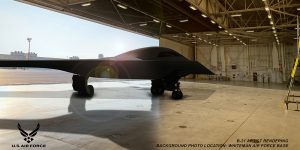The U.S. Air Force (USAF) and U.S. defense contractor Northrop Grumman released photorealistic renderings of the service’s new B-21 “Raider” long-range strategic bomber tucked away in hangars at USAF bases in South Dakota, Missouri, and Texas on January 31.
The three renderings are the first images of the bomber since its name was announced at the Air Force Association Air, Space & Cyber Conference in September 2016.
In July 2019, the USAF Vice Chief of Staff, General Stephen Wilson, indicated that the B-21 will make its maiden flight sometime in December 2021, although the date was questioned in late October 2019 by the head of the USAF’s Rapid Capabilities Office (RCO), Randy Walden.
Given the USAF’s past experience with “large components coming together, integration, ground test all the things that lead up to first flight have to be accomplished,” Walden was quoted as saying by Air Force Magazine. “So, I would not bet on that date.”
However, according to a July 2019 statement made by USAF Chief of Staff, General David Goldfein, the B-21 program is on schedule.
The aircraft is being developed and built by Northrop Grumman. The company was awarded a contract in October 2015 that covered the Engineering and Manufacturing Development (EMD) phase as well as the first five production lots to cover the production of the first 21 bombers.
The EMD phase entails developing and designing the bomber, including completing full system integration, before going into production.
The construction of a bomber prototype is currently taking place at the Air Force Plant 42 outside Palmdale, California, as The Diplomat reported in July 2019.
Technical details and other characteristics of the B-21 have not been publicly revealed.
Notably, the bomber is supposed to be mainly built from existing technologies and will also be more easily upgradeable than previous aircraft.
The B-21 will be a subsonic long-range bomber featuring a flying wing design and purportedly will carry both conventional and nuclear weapons, and be optionally manned.
The bomber’s armament will likely include the Massive Ordnance Penetrator bomb, the B-61-12 thermonuclear gravity bomb, and the Long Range Stand Off (LRSO) nuclear-capable cruise missile.
“The B-21 will be a highly survivable, next-generation bomber with the ability to penetrate modern air defenses and hold any target at risk globally,” the USAF says on its website.
The B-21 will replace the USAF’s B-1B Lancer, B-2 Spirit, and B-52H fleets. Current USAF budget plans foresee the procurement of at least 100 B-21s, at a cost of $656 million each in 2019 dollars.
However, “total procurement costs could exceed $100 billion,” I cautioned last year. “The USAF does not have a good track record in reigning in spending on its bomber force: both the B-1 and B-2 programs went massively over budget.”

































